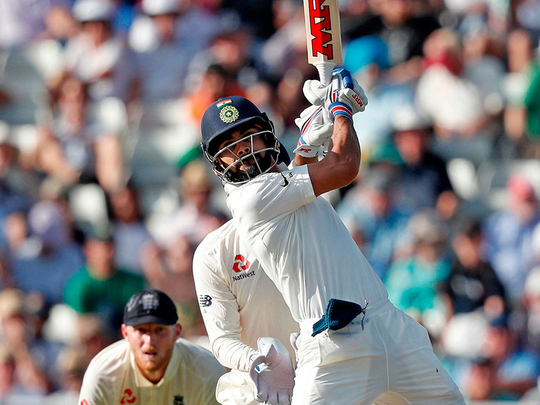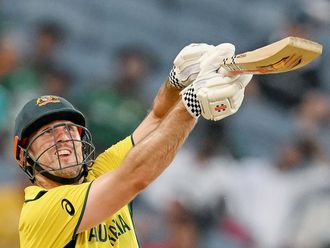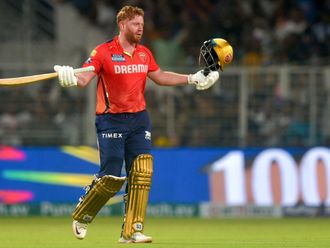
London: In September 2014, Virat Kohli returned home. He was fed up. Two months earlier, Kohli had arrived in England feted as India’s next great batting totem. Yet all England fans saw was Kohli’s technique being clinically dishevelled.
James Anderson’s excellence magnified minute flaws in the mechanics of Kohli’s technique — a slightly bottom-handed grip; and a tendency to leave his right hip too square, which disturbed his balance and so his ability to attend to balls that swung late. By the time his miserable sojourn in England — 134 runs at 13.40 apiece, including four dismissals in just 50 balls against Anderson — ended, Kohli had taken on the air of a child forlornly trying to complete a Rubik’s cube.
It represented the first time that Kohli’s inexorable ascent had been halted. And so, rather than sulk, Kohli recognised his failures for what they were: a unique learning opportunity. Over weeks and months of drills in the nets, Kohli tweaked his technique. He wanted to retain the essence of what made him one of the most precocious batsmen in the world while ensuring that never again would he be exposed as he had been by Anderson.
Kohli widened his stance to become more side-on, and moved his front toe to point towards point rather than cover.
In these moments, Kohli 2.0 was forged. The very next Test he played — his first as captain — Kohli produced one of the great batting performances of the modern age: 115 and 141 in Adelaide. Even in defeat, he embodied the aggressive cricket that he wants India to play.
In the years since Kohli has been imperious in all conditions, the world’s most compelling cricketer. Still, one inconvenient fact lingered: that record in England. “I am not sure if he has changed,” Anderson said while Kohli was ravaging England’s attack in India in 2016.
In a sense all that Kohli has done since — recalibrating his technique; excelling against South Africa’s formidable pace attack; the plan, albeit scuppered due to injury, to play County Championship cricket this summer — has been designed to ensure that he had the best possible chance of excelling this time in England.
Naturally, when Kohli entered the crease, he was greeted by Anderson, who welcomed him with an outswinger, the same delivery which had befuddled him four years ago. Immediately one change from 2014 was apparent: Kohli was batting out of his crease.
When he re-emerged after lunch, Kohli knew what awaited: the full force of Anderson, the most brilliant bowler this decade in England. With both inswing and outswing, Anderson curved the ball beautifully and late. The slip fielders lay in wait, like prowling hyenas. And as Sam Curran and Ben Stokes removed the heart of India’s middle order, it felt like only Kohli remained between India and a fatal collapse.
Somehow, Kohli survived. Partly, this owed to the sheer force of his will.
Partly, too, it owed to the porousness of Dawid Malan’s hands, which spilt a regulation slip chance on 21 off Anderson, and then a harder chance on 51 off Stokes. Yet this was also a triumph for his remodelled technique. Kohli made contact with the ball 40cm further forward than on average during the summer of 2014, a crucial tweak which helped him negate the swing.
In the context of the game, Kohli’s innings still felt a little futile, as India faced the prospect of a deficit of 100 or even more. But — imperceptibly at first, and then with mounting rapidity — the feel of this innings altered: from brilliantly stubborn captain aboard a burning ship to a player bending a game according to their will.
All the wonders of his individual shots would have been inconsequential had wickets continued to clatter around him. Kohli ensured they would not: by managing the strike masterfully. After India lost their seventh wicket, Kohli faced 75 per cent of balls, so dexterously did he find pockets of space to rotate the strike. While the tail added eight in 37 balls, he creamed 92 in 116. Kohli 2.0, born four years ago, now averages 66.34. Most extraordinarily, he has passed 50 23 times — and converted 16 of those into centuries.
By the time this innings was done, Kohli had already scored more runs than on the entire tour four years ago. He walked off, helmet off and arms aloft, with the crowd unified in applause at an innings that had transformed the complexion of a game and maybe even the series too.
Perhaps, in this moment, Kohli even had cause to be grateful for all the tumult of the 2014 tour.
For this jarring failure was the trigger for Kohli to reassess his game and explore the true outer limits of his talent.












